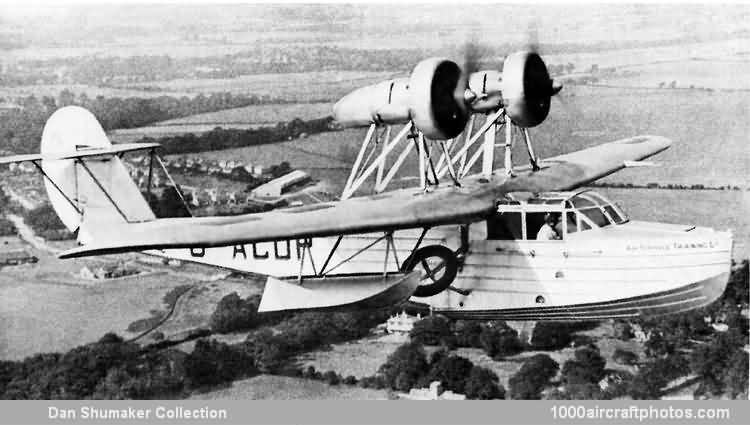02/28/2014. Remarks by Johan Visschedijk: "In 1929, S.E. Saunders Ltd. of Cowes became Saunders-Roe Ltd., a controlling interest in the firm having been acquired by Sir Alliott Verdon Roe and John Lord, the first product under the new name being the Cutty Sark civil transport flying boat. A high-wing monoplane, and the first British passenger-carrying flying boat to adopt this configuration, the Cutty Sark was initially powered by two tractor 105 hp ADC Hermes I engines mounted on pylons above the wing, well clear of spray.
A watertight Avro-Fokker wing of typical cantilever construction was fitted, deep-sectioned and plywood covered, and bolted directly to the gunwales of an all-metal Alclad-plated hull. The wing stabilizing floats were positioned close to the hull sides, and the engine nacelles were slightly angled outwards to reduce offset thrust when flying on one engine. A roomy cabin, situated forward of the leading edge of the mainplane, seated the pilot and three passengers.
The prototype, registered G-AAIP, made its first flight at Cowes on July 4, 1929, and after exhibition at the Olympia Aero Show was flown by Flying Officer Chilton to the Seaplane Rally at La Baule, St. Nazaire, France in September 1929, with the Director ofCivil Aviation, Sir Sefton Brancker, as passenger. Following this, G-AAIP was converted into an amphibian by the fitment of a wide-track outwards-retracting landing gear and a tail-skid, and thus modified was sold to Norman Holden, shortly afterwards being acquired by S.S. Kirston and R.B. Mace for a service between Southampton and Jersey.
With a limited production of Cutty Sarks under way, the performance was improved by the installation of cleanly cowled 120 hp de Havilland Gipsy II engines, and between March 26 and April 23, 1931, the manufacturers' Chief Test Pilot, S.D. Scott carried out a 3,000 mls (4,828 km) sales tour to south-east Europe and also to the Stockholm Exhibition in Sweden in June of the same year. Early in 1932, Kirston and Mace formed British Amphibious Air Lines Ltd. and bought a second Cutty Sark, G-ABBC, basing both machines at Squires Gate, Jersey and operating via Liverpool to the Isle of Man.
A total of twelve Cutty Sarks was built, the ninth machine being to the order of the Japanese pilot, Yoshihara, for a flight from San Francisco, USA to Japan, and this machine bore the British registration of G-ABVF for test flying at Cowes. It was constructed as a flying boat only, and fitted with blind flying equipment and long-range tanks was the only single-engined version of the Cutty Sark, powered by a 240 hp Armstrong Siddeley Lynx IVC.
The last three machines were powered by two 140 hp Armstrong Siddeley Genet Major I radial engines and served as training aircraft with Air Service Training Ltd. at Hamble between 1933 and 1938. A scaled-up development of the Cutty Sark was produced as the A.19 Cloud in 1930."
